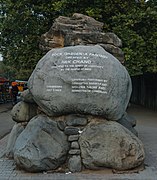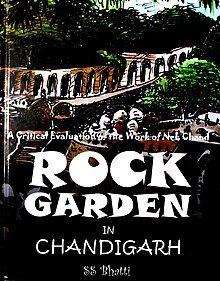
Chandigarh is a union territory and planned city in northern India, serving as the shared capital of the surrounding states, namely Punjab to the north, west and the south, and Haryana to the east. Chandigarh constitutes the bulk of the Chandigarh Capital Region or Greater Chandigarh, which also includes the adjacent satellite cities of Panchkula in Haryana and Mohali in Punjab. It is situated near the foothills of the Himalayas, 260 km north of New Delhi and 229 km southeast of Amritsar.

A rock garden, also known as a rockery and formerly as a rockwork, is a garden, or more often a part of a garden, with a landscaping framework of rocks, stones, and gravel, with planting appropriate to this setting. Usually these are small Alpine plants that need relatively little soil or water. Western rock gardens are often divided into alpine gardens, scree gardens on looser, smaller stones, and other rock gardens.

Nek Chand Saini was a self-taught Indian artist, known for building the Rock Garden of Chandigarh, an eighteen-acre sculpture garden in the city of Chandigarh.

Dr. Evermor's Forevertron is the 2nd largest scrap metal sculpture in the world, standing 50 ft. high and 120 ft. wide, and weighing 300 tons. Built in the 1980s, it is housed in Dr. Evermor's Art Park on Highway 12, in the town of Sumpter, in Sauk County, Wisconsin, United States.

Sukhna Lake in Chandigarh, India, is a reservoir at the foothills of the Himalayas. This 3 km² rain fed lake was created in 1958 by damming the Sukhna Choe, a seasonal stream coming down from the Shivalik Hills. Originally, the seasonal flow entered the lake directly, causing heavy siltation. To check the inflow of silt, 25.42 km² of land was acquired in the catchment area and put under vegetation. In 1974, the Choe was diverted and made to bypass the lake completely, the lake being fed by three siltation pots, minimizing the silt into the lake itself.
Dera Bassi is a satellite city of Chandigarh and a municipal council in Mohali district in the state of Punjab, India. Dera Bassi is located on the Chandigarh – Delhi National Highway, 8 km from Chandigarh. It is located within 20 km from Chandigarh, Mohali and Panchkula. It is strategically located near the boundary of Haryana, Punjab and Union territory of Chandigarh. Derabassi is most famous for its industrial belt, situated for the most part on Ramgarh and Barwala Road. The nearby sub town of Lalru was once a famous market for red chilli powder. The city and the nearby area host eight Engineering, B.Ed., Paramedical and Management institutes.

The Mary Nohl Art Environment is a residence in the Milwaukee suburb of Fox Point, Wisconsin. The property, which is filled with folk art created by artist Mary Nohl (1914–2001), is listed on the National Register of Historic Places.

A visionary environment or fantasy world is a large artistic installation, often on the scale of a building or sculpture parks, intended to express a vision of its creator. The subjective and personal nature of these projects often implies a marginal status for the artists involved, and there is a strong association between visionary environments and outsider art.

The Sanitary Garden or Kala Sagar is an art exhibition in Chandigarh, India consisting of sculptures made from toilets and other sanitary items.
Soumyen Bandyopadhyay is an architect and architectural historian at Liverpool University where he was head of department and holds the Sir James Stirling Chair in Architecture. He has previously held professorial positions at the Manchester School of Architecture (MSA) and Nottingham Trent University.

This is a list of the National Register of Historic Places listings in Price County, Wisconsin. It is intended to provide a comprehensive listing of entries in the National Register of Historic Places that are located in Price County, Wisconsin. The locations of National Register properties for which the latitude and longitude coordinates are included below may be seen in a map.
John Maizels, educated at Latymer Upper School, Hammersmith in the early 1960s, is the founder of Raw Vision magazine which he created in London in 1989 as a forum for the work of self-taught artists, or unknown geniuses, which he felt was overlooked and under-appreciated. Initially published biannually and now quarterly, Raw Vision remains the world's only international journal of outsider art and continues to contribute dialogue to the international field.
Saving and Preserving Arts and Cultural Environments is a non-profit public benefit organization created with an international focus on the study, documentation, and preservation of art environments and self-taught, publicly-accessible artistic activity. Currently based in Aptos, California, SPACES boasts an archive of approximately 35,000 photographs as well as hundreds of books, articles, audio and video tapes/DVDs, and artists’ documents. SPACES has become recognized internationally as the largest and most complete archive on this subject.
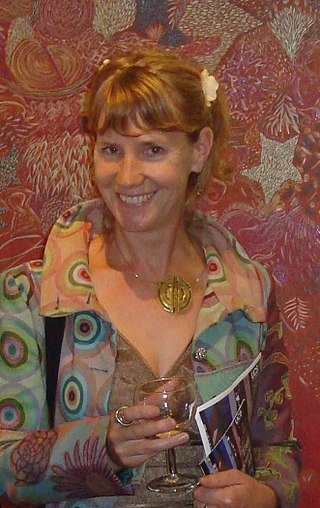
Anne Schwegmann-Fielding is a British sculptor and mosaic artist, who has been producing artworks made from recycled materials since the early 1990s.
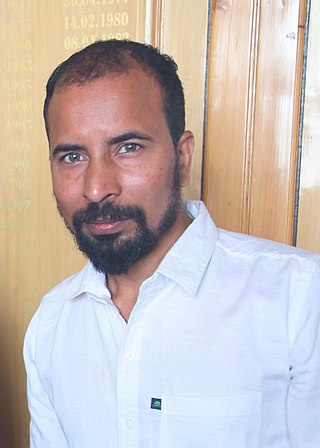
Gurpreet Singh Dhuri is an Indian sculptor, hailing from the Ghanaur Khurd Dhuri area of Punjab. Gurpreet Dhuri is known for his clay modeling and portraiture in medium of sculpture. Gurpreet Singh Dhuri loves to be called Gurpreet Dhuri and alumni of Government College of Arts, Chandigarh. His upbringing in a working-class family has taught him to be tough and work passionately to rise. But unlike many who shared similar socio economic background, he has not given up to destiny. He is a contemporary sculptor and prost artist who has worked in Punjab, Chandigarh, Delhi and Mumbai. Completed his Graduation and masters of Fine art BFA and MFA from Government College of Arts Chandigarh. He has worked as artist at dirty Hands studio for a period of five years where he was trained in pros. He is founder member of Studio hash, Delhi among other fellow artist Rake Kumar, Harpree Singh, Akash’s Gauir. Recently they have done a full figure Sili Sculpture of Shri Nek Chand maker of Rock Garden of Chandigarh.
Emery O. Blagdon was an American artist.
Joe Minter is an American sculptor based in Birmingham, Alabama. His African Village in America, on the southwest edge of Birmingham, is an ever-evolving art environment populated by sculptures he makes from scrap metal and found materials; its theme is recognition of African American history from the first arrivals of captured Africans to the present. Individual pieces from Minter's thirty-year project have been in major exhibitions in the United States and are in the permanent collections of the National Gallery of Art, the Smithsonian American Art Museum, and the Metropolitan Museum of Art, among others.
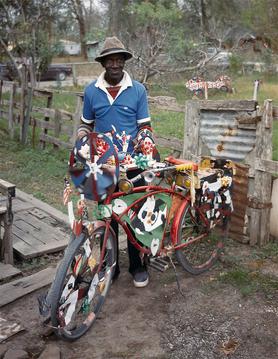
David Butler (1898–1997) was an African American sculptor and painter from Good Hope, Louisiana. His style is epitomized by kinetic sculptures made from recycled tin or wood, which he embellished with saturated colors and geometric patterns. His work is now in the permanent collections of the Smithsonian American Art Museum, the American Folk Art Museum, and the Philadelphia Museum of Art.
Ruth DeYoung Kohler II was a museum director and teacher from Wisconsin who championed under-recognized, self-taught artists and vernacular art. She was the director of the John Michael Kohler Arts Center from 1972–2016. She led the development of the Art Preserve in Sheboygan, Wisconsin, the first museum dedicated to the exhibition and conservation of artist-built environments.

The ArCHIAM Centre is an interdisciplinary research centre based at the University of Liverpool. It was founded in 2013 by Professor Soumyen Bandyopadhyay, Giamila Quattrone, Martin Goffriller and Mohammad Habib Reza.




